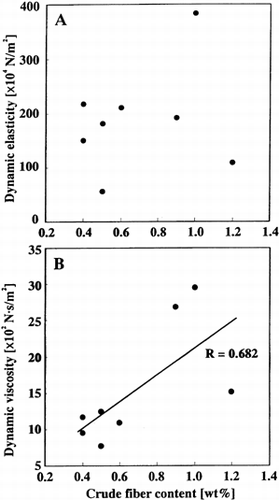ABSTRACT
Changes in electrical and rheological properties of cell tissues after freezing-thawing were measured to clarify the mechanism of freezing injury of agricultural products. The electrical property represented the state of cell plasma membrane and was measured by impedance with frequency varied from 0.1 to 1 MHz. The rheological property, measured by the vibrating reed method, showed changes in the state of cells. In the freezing of carrot tissue, the dynamic elasticity and viscosity were fairly sensitive to the loss in turgor pressure caused by the injury on the plasma membrane, through the intracellular ice crystal formation. Among eight kinds of different agricultural products after freezing-thawing, the dynamic elasticity and viscosity showed a good correlation with each other and positive correlations with crude fiber content. This suggests that the major determinants of the dynamic viscoelasticity of frozen-thawed samples are the mechanical properties of the cell wall and the intercellular structure.
INTRODUCTION
Freezing has been known to cause deteriorations in quality of agricultural products, which are generally softening of cell tissue and induction of undesirable enzymatic reactions such as browning and degradation of nutrition components. Lots of investigations on freezing of agricultural products have been focused on changes in nutrient components.Citation1-6 The effect of freezing, however, has not been studied in terms of the rheological properties of agricultural products.
The rheological properties of agricultural products reflect the state of cells represented by the turgor pressure,Citation[7] which is very sensitive to the state of plasma membrane. The plasma membrane is considered to be the primary site of the freezing injury.Citation8-10 The integrity of the plasma membrane can be analyzed by electrical measurements.Citation[11] Therefore, simultaneous measurements of electric al and rheological properties can be effective to analyze the mechanism of freezing injury of agricultural products.
In the present study, changes in electrical and rheological properties of carrot cell tissue before and after freezing-thawing were measured and the mechanism of the freezing injury was discussed. Changes in rheological properties before and after freezing-thawing were compared for eight kinds of agricultural products to analyze the relationship between rheological properties and cellular state of agricultural products.
MATERIALS AND METHODS
Agricultural Products
Agricultural products were obtained from a local market, and cylindrical samples (6.9 mm in diameter, 50 mm in length) were prepared with a cork borer (6.9 mm inner diameter) for electrical and rheological measurements.
Freezing-Thawing
Cylindrical samples were wrapped with a Parafilm (American National Can, USA) for prevention of drying and left in a refrigerator at 5°C for 30 min, and then cooled and frozen in a domestic freezer at −20°C. The temperature was measured by a copper-constantan thermocouple at the center of the sample. After freezing, samples were thawed for 1 h at room temperature.
Measurement of Impedance
Two electrodes of platinum wire (0.3 mm in diameter) connected to LCR meter (HP 4285A; Hewlett-Packard Japan) were plunged into the sample (5 mm deep) in the direction perpendicular to the long axis of the cylindrical sample (6.9 mm in diameter, 35 mm in length) as shown in Fig. . The distance between the two electrodes was 30 mm. Impedance of the sample was measured over a frequency range from 0.1 to 1 MHz at 0.1 volt. Three samples were tested at a fixed condition and the mean impedance value was obtained.
Measurement of Rheological Properties
Rheological properties of agricultural products were determined by the vibrating reed method.Citation12-13 The experimental apparatus for measurements by this method is shown in Fig. . Cylindrical samples were dipped in liquid paraffin (Nacalai tesque, inc., Kyoto, Japan) to prevent drying during the measurement. The top end of the cylindrical beam sample (6.9 mm in diameter, 35∼45mm in length) was held by a sample holder of acrylic resin, and vibrated at the frequency varied from 0 to 100 Hz by an electromagnetic vibrator (Model PET-0A; IMV Corporation, Japan). The movement of the bottom edge as a free end of the beam was measured by a laser displacement sensor (LK-030; Keyence Corporation, Japan), and the resonance curve was analyzed. Dynamic elasticity (E′[N/m2]) and dynamic viscosity (η′[Nċs/m2]) were calculated from the following equations.Citation[14]
Figure 2. Schematic diagram of experimental apparatus for measurements of rheological properties using the vibrating reed method.
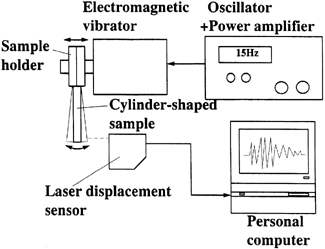
Moisture Contents of Agricultural Products
The moisture content of sample was determined by the air-oven method, which involves drying 17 h at 105°C. Three samples were used and the mean value was obtained.
RESULTS AND DISCUSSION
Electrical Property of Carrot Tissue
Typical impedance curves of cell tissues before and after freezing-thawing at −20°C are shown in Fig. in the frequency range from 0.1 to 1 MHz. At the low frequency range (∼0.1 MHz), a substantial change in impedance was observed before and after freezing-thawing. The change was small at the higher frequency range (∼1 MHz). Each plotted point in Fig. was an average impedance of the three samples. The mean value of standard deviations among three samples was 0.78 kΩ.
Figure 3. Effect of freezing time during the freezing process to − 20°C on the impedance curve of carrot tissue samples after thawing. (•, 0 min; ○, 2.5 min; ▴, 10.5 min; ▵, 18.5 min; ▪, 26.5 min; □, 34.5 min).
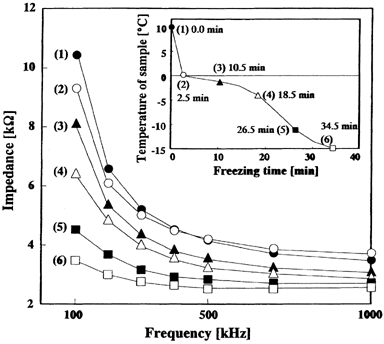
Figure also shows the effect of freezing time at −20°C on impedance curves of carrot tissues after thawing. Substantial change in impedance was observed with freezing time. The change in the temperature at the center of the sample is also shown in Fig. . This shows that the temperature of the sample plays an important role to change the impedance of carrot tissue. The temperature of the sample reflects the ratio of frozen part in the sample during the freezing process.
The electrical response at the lower frequency reflects the state of tissue cells, especially, the intactness of plasma membrane.Citation[11], Citation15-19 The plasma membrane structure composed of phospholipid double layers causes a strong electrical resistance in the cell tissue sample. The plasma membrane of plant cells has poor water permeability as compared with microbial and animal cells in the freeze-induced osmotic dehydration process. Plant cells are easily susceptible to intracellular ice crystal formation in freezing, leading to the damage on plasma membrane.Citation[18] This causes a drastic reduction in electrical resistance of the cell tissue. Therefore, we employ the impedance at 100 kHz (Z 100) as an index of the intactness of plasma membrane.
Rheological Properties of Carrot Tissue
Typical resonance curve obtained by the vibrating reed method is shown for a carrot sample (l=3.5 cm, D=0.69 cm, ρ=1.03 g/cm3) in Fig. . A sharp peak (f) at 60 Hz and peak width (Δf) of 6.7 Hz were observed for a fresh sample before freezing and E′ and η′ were calculated by Eqs. Equation1 and Equation2 to be 5.94×106 N/m2 and 1.76×103 Nċs/m2, respectively. After freezing-thawing, f and Δf became 23.5 Hz and 5.4 Hz, and E ′ and η′ were calculated to be 8.98×105 N/m2 and 1.40×103 Nċs/m2, respectively.
Figure 4. Typical resonance curves for carrot tissue sample before and after freezing-thawing obtained with vibrating reed method.
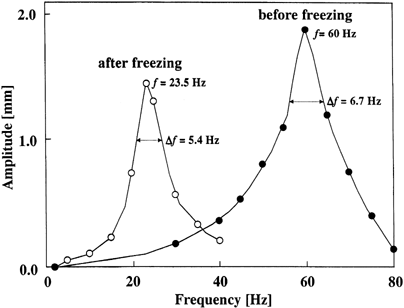
Rheological properties of agricultural products have been generally measured by the stress relaxation and/or force deformation methods.Citation[20] These methods, however, may have a difficulty in the mechanical coupling of the solid sample and a detector. The vibrating reed method, on the other hand, utilizes a free vibration of a cantilever and no mechanical coupling is required between the sample and the detector making this method convenient for the measurement of rheological properties of agricultural products.
Comparison of Electrical and Rheological Properties of Carrot Tissue in Freezing Process
Figure shows changes in impedance and dynamic viscoelasticity of carrot cell tissue samples with time in the freezing process at −20°C. The impedance began to decrease when the sample temperature reached the freezing point (−0.9°C). The dynamic elasticity and the viscosity of the cell tissue after thawing decreased along with a decrease in impedance.
Figure 5. Changes in impedance, dynamic elasticity, dynamic viscosity, and temperature during the freezing process of carrot tissue sample at −20°C.

Figure compares the relative dynamic elasticity (E′/E ′0; E ′0, elasticity before freezing) and the relative viscosity (η′/η′ 0; η′0, viscosity before freezing) with the relative impedance (Z 100/Z 100 0; Z 100 0, impedance before freezing) for frozen-thawed carrot tissue at different freezing time. The logarithm of the relative elasticity and the relative viscosity are linearly dependent on the relative impedance as follows:
Figure 6. Correlation between impedance and dynamic elasticity (A) or dynamic viscosity (B) of carrot tissue samples with different time in the freezing process at −20°C.
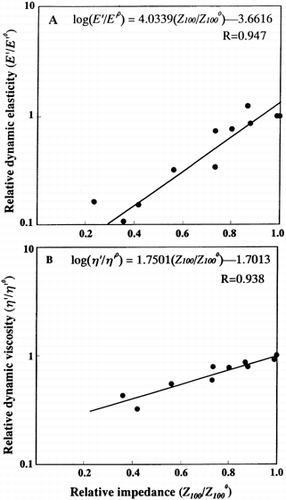
Change in Rheological Properties of Various Agricultural Products Through Freezing-Thawing
The rheological properties of eight kinds of agricultural products were measured before and after freezing-thawing at −20°C. Results are summarized in Table along with moisture content and crude fiber content.Citation[21] The values of the dynamic elasticity of agricultural products tested here were mostly in the order of 106 N/m2. This was decreased drastically by almost two order of magnitude after freezing-thawing. On the contrary, the values of the dynamic viscosity were in the order of 103 Nċs/m2. This was also decreased after freezing-thawing by less than one order of magnitude. These results show that the freezing injury of agricultural products is most sensitive to dynamic elasticity. Ramana and TaylorCitation[20] reported on the shear modulus of vegetables during freezing and cooking. The present results of dynamic elasticity seem consistent with their results on the shear modulus.
Figure compares the dynamic elasticity and the dynamic viscosity of the eight agricultural products before and after freezing-thawing. Correlation is very poor before freezing (Fig. A) but acceptable after freezing-thawing (Fig. B, R=0.985). Before freezing, the elasticity of agricultural products was high because of the turgor pressure of cells,Citation[7] which may not contribute much to the viscosity. Instead, the viscosity before freezing may be determined by the mechanical properties of the cell wall and the intercellular structure. Following freezing-thawing, however, the turgor pressure was lost by the damage on plasma membrane.Citation[11] In this case, the elasticity and viscosity appear to be determined by a similar mechanism thus showing a good correlation between them (Fig. B).
Table 1. Dynamic Viscoelasticity Before and After Freezing and Chemical Properties of Agricultural Products
Figure 7. Correlation between dynamic elasticity and viscosity for various agricultural products before (A) and after freezing-thawing (B).

To rationalize this mechanism, the dynamic elasticity and viscosity were compared with water contents (solid contents) of samples after freezing-thawing, as shown in Fig. . No correlation with the solid content was observed both for the elasticity and the viscosity. Figure compares the elasticity and the viscosity with the crude fiber content of frozen-thawed samples. In this case, positive correlations are observed both for the elasticity (R=0.708) and the viscosity (R=0.694) with the crude fiber content. Although the correlation coefficients may not be satisfactory, agricultural products with crude fiber content higher than 0.9% show higher elasticity (Fig. A) and viscosity (Fig. B) than those with a fiber content lower than 0.6%. Crude fiber content, thus, seems to be the major determinant of mechanical properties of the cell wall and the intercellular structure.
Figure 8. Dependence of dynamic elasticity (A) and viscosity (B) of agricultural products on water content (solid content) for samples after freezing-thawing.
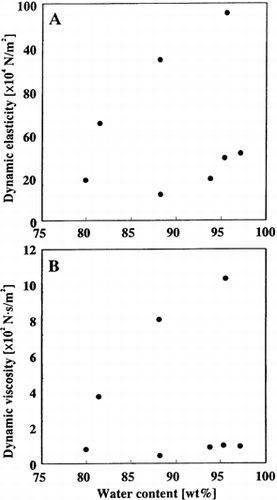
Figure 9. Dependence of dynamic elasticity (A) and viscosity (B) of agricultural products on crude fiber content for samples after freezing-thawing.

On the contrary, the correlation between elasticity and crude fiber content was poor for the samples before freezing (Fig. A). In this case, the turgor pressure is the major determinant of the elasticity of agricultural products. The viscosity, however, showed some correlation with the crude fiber content even for samples before freezing (Fig. B) suggesting different mechanisms determining the elasticity and the viscosity of fresh samples in agricultural products.
CONCLUSIONS
A large change in impedance before and after freezing was observed for a carrot tissue sample representing the damage on plasma membrane by freezing. This damage on plasma membrane induced a loss in turgor pressure of the cells, and caused a substantial decrease in the dynamic elasticity and viscosity of the carrot cell tissue. This was effectively measured by the vibrating reed method.
Changes in viscoelasiticity before and after freezing were measured and compared for eight kind of agricultural products. Among samples of different origin, dynamic elasticity showed a good correlation with dynamic viscosity after freezing-thawing suggesting a similar mechanism determining elasticity and viscosity. No correlation between the two parameters was observed for fresh samples because of the predominant effect of the turgor pressure of cells. Dynamic elasticity and viscosity of frozen-thawed samples showed a positive correlation with crude fiber content, suggesting the important contribution of the cell wall and the intercellular structure on viscoelasticity of agricultural products after freezing-thawing.
Acknowledgments
REFERENCES
- Aparicio-cuesta , M.P. and Garcia-moreno , C. 1988 . Quality of Frozen Cauliflower during Storage . J. Food Sci. , 53 : 491 – 493 .
- Lisiewska , S. and Kmiecik , W. 1996 . Effects of Level of Nitrogen Fertilizer, Processing Conditions and Period of Storage of Frozen Broccoli and Cauliflower on Vitamin C Retention . Food Chem. , 57 : 267 – 270 .
- Lisiewska , Z. and Kmiecik , W. 1997 . Effect of Freezing and Storage on Quality Factors in Hamburg and Leafy Parsley . Food Chem. , 4 : 633 – 637 .
- Bartolomé , A.P. , Rupérez , P. and Fúster , C. 1996 . Changes in Soluble Sugars of Two Pineapple Fruit Cultivars during Frozen Storage . Food Chem. , 56 : 163 – 166 .
- Bartolomé , A.P. , Rupérez , P. and Fúster , C. 1996 . Non-Volatile Organic Acids, pH and Titratable Acidity Changes in Pineapple Fruit Slices during Frozen Storage . J. Sci. Food Agric. , 70 : 475 – 480 .
- Torija , E. , Díez , C. , Matallana , C. , Camara , M. , Camacho , E. and Mazarío , P. 1998 . Influence of Freezing Process on Free Sugars Content of Papaya and Banana Fruits . J. Sci. Food Agric. , 76 : 315 – 319 .
- Virgin , H. 1955 . A New Method for the Determination of the Turgor of Plant Tissues . Physiol Plant. , 8 : 954 – 962 .
- Burke , M.J. , Gusta , L.V. , Quamme , H.A. , Weiser , C.J. and Li , P.H. 1976 . Freezing and Injury in Plants . Ann. Rev. Plant Physiol. , 27 : 507 – 528 .
- Steponkus , P.L. 1984 . Role of Plasma Membrane in Freezing Injury and Cold Acclimation . Ann. Rev. Plant Physiol. , 35 : 543 – 584 .
- Webb , M.S. , Uemura , M. and Steponkus , P.L. 1994 . A Comparison of Freezing Injury in Oat and Rye: Two Cereals at the Extremes of Freezing Tolerance . Plant Physiol. , 104 : 467 – 478 .
- Ishikawa , E. , Bae , S.K. , Miyawaki , O. , Nakamura , K. , Shiinoki , Y. and Ito , K. 1997 . Freezing Injury of Cultured Rice Cells Analyzed by Dielectric Measurement . J. Ferment. Bioeng. , 83 : 222 – 226 .
- Drake , B. 1962 . Automatic Recording of Vibrational Properties of Foodstuffs . J. Food Sci. , 27 : 182 – 188 .
- Miyawaki , O. and Yano , T. Physical Properties of Agricultural Products (in Japanese).Physical Properties of Food , 6 Edited by: Yamano , Y. 115 – 129 . Tokyo, Japan : Shokuhin Shizai Kenkyu Ka .
- Nishinari , K. , Kuji , K. , Karaki , Y. and Koide , S. 1977 . Transverse Vibrations of Visco elastic Cylinders . Japanese J. Appl. Phys. , 16 : 19 – 27 .
- Hayden , R.I. , Moyse , C.A. , Calder , F.W. , Crawford , D.P. and Fensom , D.S. 1969 . Electrical Impedance Studies on Potato and Alfalfa Tissue . J. Exp. Botany. , 20 : 177 – 200 .
- Zhang , M.I.N. and Willson , J.H.M. 1991 . Electrical Impedance Analysis in Plant Tissue: The Effect of Freeze-Thaw Injury on the Electrical Properties of Potato Tuber and Carrot Root Tissues . Can. J. Plant Sci. , 72 : 545 – 553 .
- Zhang , M.I.N. and Willson , J.H.M. 1992 . Electrical Impedance Analysis in Plant Tissues: In Vivo Detection of Freezing Injury . Can. J. Botany. , 70 : 2254 – 2258 .
- Ishikawa , E. , Miyawaki , O. and Nakamura , K. 1997 . Water Permeability of Plasma Membranes of Cultured Rice, Grape, and CH27 Cells Measured Dielectrically . Biosci. Biotechnol. Biochem. , 61 : 1826 – 1830 .
- Toyoda , K. , Kojima , H. , Miyomoto , S. and Takeuchi , R. 1997 . Measurement and Analysis of Moisture Changes in Agricultural Products using FFT Noise Impedance Spectroscopy . Drying Technol. , 15 : 2025 – 2035 .
- Ramana , S.V. and Taylor , A.J. 1992 . Dynamic Measurement of Tissue Rigidity during Freezing and Cooking of Vegetables . J. Sci. Food Agric. , 58 : 261 – 266 .
- Kagawa , Y. 1998 . Standard Tables of Food Composition in Japan (in Japanese) Tokyo, Japan : Kagawa Nutrition Univ. Pub. Div. .

